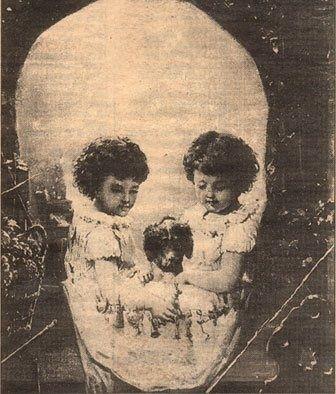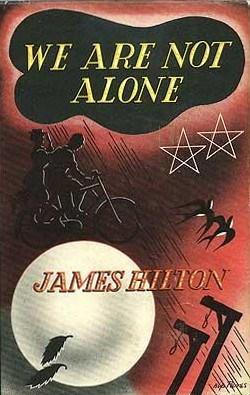Book review by George S: James Hilton wrote this novel after he had moved to Hollywood, and it reads rather like a movie treatment. We begin with opening shots of a cosy English cathedral town. A house is being demolished to make room for a department store, and people are reminiscing nostalgically: ‘That was where the little doctor lived.’ An oddity is that a picture still hanging on the wall is
a fading etching of angels grouped around an arch of flowers, but when viewed at more than arm’s length the whole design took on the likeness of a human skull.
A picture, I suppose, on the same principle as this one:

This should be taken, I suppose, as a hint that the events of the story will be capable of two utterly contradictory interpretations. An indication that events will have a darkish hue is given when we are told that:
the little doctor, who had lived in that house for years, was finally hanged for the murder of his wife.
The little doctor is David, and is presented as unworldly and innocent, an impractical man trapped in a disappointing marriage. Jessica, his wife, is much more practical; sheis disappoined with his lack of worldly progress, especially in the local social scene. She nags him. They have one son, who is delicate and emotional.
The story takes off when the doctor is called in to take care of a dancer at the local theater who has hurt her arm.. She is Leni, a German and deeply depressed because she has damaged her arm, and will lose her job if unable to dance. A while later, by chance, he is in a seaside town where she has been appearing in a pierrot show. She has attempted suicide because she is no longer employable as a dancer. The little doctor, called in again, takes care of her; he books her in for the night at a local hotel without thinking how this looks to nasty-minded gossips, and then offers her a job as a nanny, looking after his son.
The book settles down into a pattern familiar from middlebrow fiction. The doctor is a total innocent and therefore vulnerable to gossip. His wife is unpleasant and repressed. She does not like it when in all innocence he helps a pretty young girl. It is the pattern found in books like A.S.M. Hutchinson’s If Winter Comes and other novels – a highly improbable conflict between utter innocence on the one hand and worldly-wise narrow-mindedness on the other.
The wife plays true to type, becoming intensely jealous of the dancer and dismissing her – even though the highly-strung boy responds to her kindness (though he is put off by his mother’s frigid virtue).
The dismissal of Leni comes at exactly the moment when the First World War is declared, when being German will expose her to prejudice. The doctor decides to see her to the coast, from where she can return home safely – but as they board ship they are arrested fo the murder of Jessica.
 Cover of the first edition.
Cover of the first edition.
They are found guilty, and in David’s condemned cell the two lovers are allowed a last poignant meeting. After that David delivers a powerful anti-war speech to the governor and chaplain, expressing his horror at the thought of any kind of killing:
‘I don’t think I could ever kill anybody. [ …] War is killing. How could I spend so many years fighting for life and then fight against it?
The governor cannot understand how any murderer could say this, and thinks the man must be mad… The little doctor goes placidly to his date with the hangman ‘after a night no more troubled than many previous nights.’
An epilogue to the story gives another possible explanation for Jessica’s death – though things are left tantalisingly just a little uncertain.
I did not greatly enjoy this book, mostly because of its melodramatic and obvious contrast between good and bad characters. Jessica has no redeeming features, while the doctor is impossibly innocent. We are asked to believe that a man in a failed marriage will have a close relationship with a beautiful young ballet dancer without having any remotely sexual feelings for her. Male virtue is defined as sexless, while females are represented either as vulnerable virgins or as frigid harridans.
It is as though Hilton, now a screenwriter, has internalised the Hayes Cose, the Hollywood rules that minimised sexuality in the movies. It limits him as a novelist, and I can’t help feeling that inside this novel there is another, more realistic, more complex one trying to get out.
The book was filmed in 1939 with Paul Muni as the doctor and Flora Robson as Jessica. Maybe she would have made something of the part; she was an excellent actress.
